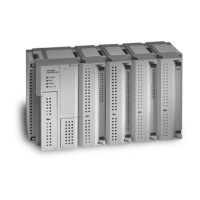5: SPECIAL FUNCTIONS
OPENNET CONTROLLER USER’S MANUAL 5-17
Key Matrix Circuit
The key matrix structure includes sequentially-numbered input points along the top and sequentially-numbered output
points along the side. The I/O connecting blocks include a diode and a switch, as shown below.
Internal Relay Allocation
The example of a key matrix configuration shown on page 5-16 stores input information to 30 internal relays starting with
internal relay M100. The switches are assigned to internal relays as shown below:
Outputs
Inputs
I0 I1 I2 I3 I4 I5
Q0
M100
(SW00)
M101
(SW01)
M102
(SW02)
M103
(SW03)
M104
(SW04)
M105
(SW05)
Q1
M106
(SW10)
M107
(SW11)
M110
(SW12)
M111
(SW13)
M112
(SW14)
M113
(SW15)
Q2
M114
(SW20)
M115
(SW21)
M116
(SW22)
M117
(SW23)
M120
(SW24)
M121
(SW25)
Q3
M122
(SW30)
M123
(SW31)
M124
(SW32)
M125
(SW33)
M126
(SW34)
M127
(SW35)
Q4
M130
(SW40)
M131
(SW41)
M132
(SW42)
M133
(SW43)
M134
(SW44)
M135
(SW45)
SW10
SW00
SW20
SW30
SW40
SW21
SW31
SW41
SW12
SW32
SW42
SW13
SW23
SW43
SW14
SW24
SW34
SW15
SW25
SW35
SW45
SW11
SW22
SW33
SW44
SW01 SW02 SW03 SW04 SW05
Output
Q0
Q1
Qn
Q2
Q3
Q4
Q5
Transistor
Sink Output
Module
Input I0 I1 I2 I3 I4 I5 In
DC Input Module
Output
Q0
Q1
Q2
Q3
Q4
Note: For the circuit above, a transistor sink output module must be used. When
using a transistor protect source output module, reverse the direction of diodes.
Diode rating is:
Average rectified current ≥ 100 mA
Reverse voltage ≥ 100V DC
Use switches with superior contact reliability.
Phone: 800.894.0412 - Fax: 888.723.4773 - Web: www.clrwtr.com - Email: info@clrwtr.com

